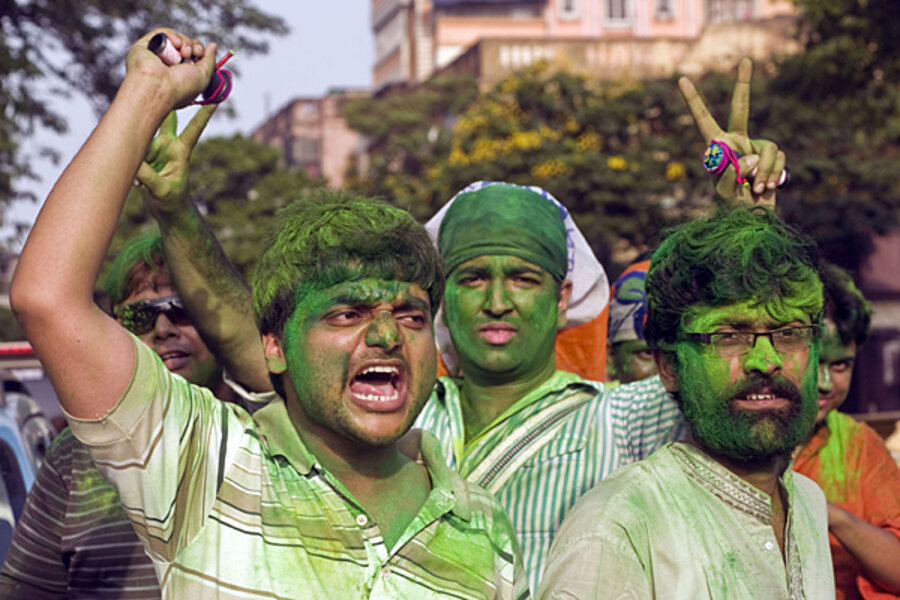What's next for India's Communist Party?
Loading...
| Calcutta, India
For years, the hammer and sickle – a symbol of more than three decades of Communist Party rule in the Indian state of West Bengal – has flown proudly over the state capital of Calcutta. Across this crumbling metropolis of 14 million, red communist flags hang limply from lampposts and hand-painted murals cover the sides of colonial-era buildings. A statue of Lenin stands at the edge of a famous park, gazing with furrowed brow over a traffic-choked intersection.
But after 34 years in power – the world's longest tenure by an elected Communist Party – the red sun may be finally setting in West Bengal, signaling a major shift not just for the Indian state but for other parts of India where communist parties have been historically powerful. At state elections in May, the left suffered a landslide defeat and the familiar communist iconography has been slowly pushed aside by the Trinamool Congress’s green and orange insignia. Experts chalk the defeat up to corruption, complacency, and shortsighted economic policies.
“A question mark hangs over the future of the Indian left,” says Calcutta-based journalist Ashis Biswas.
The communists came to power in West Bengal in 1977 on the back of strong support from industrial workers and the rural poor. They are now struggling to come to grips with the magnitude of the elections in May, which have upended the political order, slashing the representation of the Communist Party of India (Marxist), known as the CPI(M), in the 294-seat state assembly from 233 seats to just 62.
“We are still trying to get over the shock,” says Subrata Bose, a former member of parliament from the Forward Bloc, part of the CPI(M)-led Left Front government. Mr. Bose, a nephew of India’s wartime hero Subhas Chandra Bose, says morale within the communist movement is now at an all-time low, with many young cadres jumping ship to share the spoils of the new government. “We are hated now. We are not getting new members…. People are trying to join the party that has come to power,” he says.
How it happened
Along with Kerala and tiny Tripura, West Bengal is one of just three Indian states to have elected a communist government, but it has historically been communism’s largest supporter in India. After its initial victory in 1977, the CPI(M) won the next six elections by large margins on the back of strong support for its rural land reform program. Even when West Bengal’s economy took a downturn in the mid-1990s, hamstrung by the constant strikes and work disruptions of CPI(M)’s militant trade unions, it continued to win big at the ballot box.
Laveesh Bhandari, an economist who co-wrote a 2009 report on West Bengal’s economy, says widespread youth unemployment was a key factor that helped tip the scales against the CPI(M). “What brought the communists to power was widespread anger against exploitation,” he says. “What took them out was anger against unmet expectations.”
A 2007 government crackdown when police shot and killed at least 30 villagers who opposed a government plan to acquire land for a large chemical plant at Nandigram, in the Purba Medinipur District, solidified the downturn for the party. Footage of the crackdown was beamed across India. “The brutality of the police action in a left-ruled state shocked the country,” says Mr. Biswas. “The left lost its credibility as a pro-poor entity.”
New contender
West Bengal’s communists now have to contend with the powerful new Chief Minister Mamata Banerjee, a former railways minister who emerged trumpeting transparency from virtual obscurity to topple the CPI(M).
“She is a No. 1 lady,” says Mahir Daj, a taxi driver, who praised Ms. Banerjee for lifting taxes and lowering the price of gas.
Says Sanjar Agarwal, a chef working at Kolkata’s Sonar Bangla Hotel: “We want a fine, clean, and corruption-free country, and Mamata Banerjee is going in the right direction at the moment.” Asked if the communists could ever mount a revival in West Bengal, he says, “Never. It’s doomsday for them at the moment.”
Still, in a 2009 diplomatic cable, US diplomats expressed skepticism about Banerjee’s populist message of “change West Bengal can believe in.”
And so do many holdouts in the Communist Party. Narayan Datta, the editor of the CPI(M) Party mouthpiece Ganashakti, insists mismanagement and the “complacency” of party cadres were responsible for the communist downfall. Mr. Datta, who joined the CPI(M)’s student wing during the 1960s, says, “If communism was dead, if Marxism was dead, communism wouldn’t have gained the support of the people.”
Banerjee’s populism, he says, is nothing more than a “gimmick,” something that will become clear once the communists reconnect with their core rural constituencies. “We have to work with the people. We have to gain the confidence that we lost. This is a long process, but we are determined we can regain their confidence,” Datta says.
Biswas says the setback in West Bengal hints at a wider crisis for India’s communists. Most worryingly, he said, the national decline of the parliamentary left in a country with such gaping disparities between rich and poor could easily open up a vacuum for the radical Maoist insurgency currently garnering support in large swaths of the Indian countryside.
“The defeat of the CPI(M) signals a major change in Indian politics,” Biswas says.





